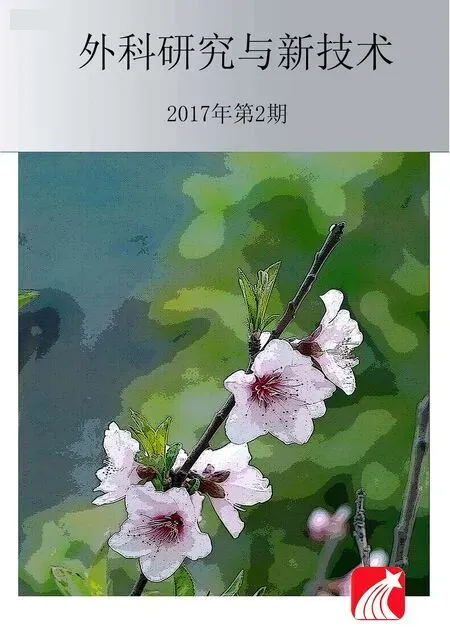光学相干断层成像技术在冠心病慢性完全闭塞介入治疗中的应用进展
蔡斌(综述),许嘉鸿(审校)
同济大学附属同济医院心内科,上海200065
光学相干断层成像技术在冠心病慢性完全闭塞介入治疗中的应用进展
蔡斌(综述),许嘉鸿(审校)
同济大学附属同济医院心内科,上海200065
冠心病慢性完全闭塞是冠心病中最为严重的病变类型,在介入治疗中开通难度大,术后并发症多。光学相干断层成像技术具有分辨率高,组织相关性良好等特点。在临床应用中,应用光学相干断层成像技术能够在介入治疗前对慢性完全闭塞血管进行评估,术中指导导丝通过病变,术后评估边缘夹层、支架贴壁不良等并发症,为支架植入提供更多的临床信息。现就光学相关断层成像在冠心病慢性完全闭塞病变中的应用进展进行简要介绍。
冠心病;光学相干断层成像;慢性完全闭塞;介入治疗
在冠状动脉粥样硬化性心脏病(冠心病)治疗的发展历程中,冠状动脉造影是诊断冠心病的金标准,也是评估冠状动脉狭窄的重要技术手段[1]。然而冠状动脉造影在获得管腔解剖结构及评估斑块性质上存在明显缺陷。光学相干断层成像技术(optical coherence tomography,OCT)是一种血管内成像技术,具有较高的分辨率,是能够获得生物组织内部微观结构的高分辨率图像的介入影像学技术。传统的时域OCT(fourier domain optical coherence tomography,FDOCT)技术成像时需要用球囊阻塞病变血管近端,易引起远端组织缺血,而新一代频域OCT(time domain optical coherence tomography,TD-OCT)技术成像时无需阻断病变血管,成像速度快,有效地减少了组织缺血并发症的发生率。同时,FD-OCT较TD-OCT提高了空间分辨率。这些检查技术上的进展让OCT技术得以在临床上得到广泛应用[2]。
慢性完全闭塞(chronic total occlusion,CTO)是冠心病中最为严重的血管病变类型,大约占介入治疗数量的20%[3]。CTO在冠心病介入治疗中开通难度大,术后并发症多,所以在CTO介入治疗中,对于病变血管管腔解剖结构及板块性质的评估,在手术方案及治疗策略的选择中具有重要意义。除此之外,在CTO介入治疗中,最大的难点在于能否准确找到真腔并通过病变管腔。OCT对于CTO病变预后,评估支架内膜覆盖、边缘夹层、支架贴壁不良等因素能够帮助指导抗血小板治疗方案,对于支架内血栓形成及主要不良事件具有提示作用。
1 OCT在CTO介入治疗术前血管评估的应用
CTO通常闭塞时间长,伴有严重钙化,OCT具有高分辨率的特点,可以辨别钙化斑块和脂质斑块,识别新生薄帽纤维斑块[4],为介入治疗提供详尽的管腔轮廓情况。典型的CTO病变通常包含近端纤维钙化帽,远端纤维帽,中央动脉粥样硬化斑块血栓[5-6]。Nigel等[7]通过对外周截肢患者动脉血管使用OCT进行体外成像,发现OCT可以准确区分闭塞腔体与腔体下方的血管壁,良好地显示病变血管的组织学特点。OCT无论在CTO及稳定性心绞痛中,都能够显示血栓的结构特点[8]。冠状动脉粥样硬化斑块内微血管的形成是CTO病变的另一病理学特征,微血管的评估对于不稳定斑块有提示作用,OCT对于微血管可进行较全面的检查[9]。此外,OCT对于STEMI患者支架植入前血栓负荷评估具有价值[10]。
2 OCT在CTO介入治疗术中的应用
CTO介入治疗中,导管通过病变血管技术难度大,手术风险高。随着实时OCT及频域OCT的出现,OCT越来越多的运用于指导CTO病变血管再通[11]。在CTO介入治疗中,导丝应尽量通过冠状动脉真腔重建血管,避免进入假腔。OCT结合新型导管技术,为CTO的介入治疗提供了便利。OCT指导下药物洗脱球囊的应用,为不能耐受双重抗血小板聚集患者提供了更多的治疗方案选择[12]。
3 OCT在支架植入术后内膜覆盖的评估
内膜未完全覆盖支架柱与支架内血栓的发生相关[13]。虽然支架内血栓发生率不高,但是一旦发生,死亡发生率达45%[14]。OCT能够清晰显示血管壁的细微结构和支架支撑杆新生内膜的厚度[15],在评估支架内皮覆盖方面,OCT优于血管内超声(intravascularultrasound,IVUS)[16]。近期一项研究表明,OCT指导下相较于仅使用冠脉造影,在non-STEMI患者PCI术后6个月随访Nobori双重药物洗脱支架内膜覆盖率得到提高[17]。但是在OCT评估血管内膜覆盖方面尚存争议,2014年一项病例报告[18],生物可吸收支架术后患者,连续应用18个月双重抗血小板聚集治疗后仍出现不完全支架内闭塞,OCT在内皮覆盖良好与未覆盖表现无差异。在这个病例中,局部血流剪切应力的差异可解释生物可降解支架完全内膜覆盖和未覆盖在OCT中表现为相同的显像。这个病例也提示了生物可降解支架植入并连续阿司匹林联合氯吡格雷双重抗血小板聚集治疗12个月后,还需进一步研究双重抗血小板治疗的最佳之间,尤其是针对复杂病变的治疗。
4 OCT在支架贴壁不良、边缘夹层上的评估
支架贴壁不良是指支架到管腔表面的距离,大于支架柱厚度加药物涂层的厚度[19]。冠脉造影很难对支架贴壁不良准确识别,血管内超声(IVUS)对于支架贴壁不良也不能很好界定。OCT可以显示支架边缘的形态和特征,FD-OCT在探测支架附壁不良、边缘夹层较IVUS更敏感,在管腔与支架尺寸的评估中与IVUS相当[20]。CTO病变常伴管腔严重钙化,更易出现支架贴壁不良。OCT对于支架植入后支架边缘细节,对于支架植入术后即刻贴壁不良能够良好识别。有研究提示随访至术后10个月,OCT评价药物洗脱支架晚期贴壁不良的主要来源为术后即刻贴壁不良持续存在[21]。球囊扩张及支架释放的过程中,不可避免地会引起血管的机械性损伤,最常见的就是支架边缘夹层的形成[22]。对于发现已存在边缘夹层的患者,详细的OCT评估边缘夹层可能影响并发症的后续管理[23],对于不阻塞血流的较小的表面的夹层无需给予干预。
5 OCT在冠心病CTO介入治疗中的不足
OCT虽具有高分辨率、成像迅速等优点,但是OCT的穿透力差,现阶段OCT成像系统的组织穿透最大厚度仅2 mm,对于斑块深部的病变,缺乏诊断的特异性。FD-OCT较上一代的时域OCT具有图像质量佳、扫描速度快、不需要球囊阻闭血管的优势,但FD-OCT成像需注入稀释碘剂,易造成左主干开口显影不清晰。CTO病变常伴有严重钙化及血管迂曲,OCT的成像设备难以通过扭曲的血管,OCT成像材料多为光导纤维组成,在通过扭曲血管的过程中易折断,对操作要求高。
CTO的介入治疗成功率远低于非CTO病变。虽然现无大规模前瞻性随机对照试验探讨OCT指导PCI治疗,但对于CTO病变详细评估血管组织学特点、血栓负荷,术后评估支架内膜覆盖、支架贴壁、边缘夹层情况可对介入治疗提供更全面的信息,同时也可指导术后抗血小板治疗方案。
[1]Amsterdam EA,Wenger NK,Brindis RG,et al.2014 AHA/ACC Guideline for the Management of Patients with Non-ST-Elevation Acute Coronary Syndromes:Executive Summary a Report of the American College of Cardiology/American Heart Association Task Force on Practice Guidelines[J].Circulation,2014,130(25): 2354-2394.
[2]Terashima M,Kaneda H,Suzuki T.The role of optical coherence tomography in coronary intervention[J].Korean J Intern Med,2012,27(1):1-12.
[3]Fefer P,Knudtson ML,Cheema AN,et al.Current perspectives on coronary chronic total occlusions:the Canadian Multicenter Chronic Total Occlusions Registry[J].JAm Coll Cardiol,2012,59(11):991.
[4]Ishibashi K,Tanaka A,Kitabata H,et al.Clinical significance of low signal intensity area surrounding stent struts identified by optical coherence tomography[J].Int Heart J,2013,54(1):7-10.
[5]Fefer P,Robert N,Qiang B,et al.Characterisation of a novel porcine coronary artery CTOmodel[J].Euro Intervention,2012,7(12):1444-1452.
[6]Strauss BH,Segev A,W right GA,et al.Microvessels in chronic total occlusions:pathways for successful guidewire crossing?[J].J Interv Cardiol,2005,18(6):425-436.
[7]Munce NR,Yang VXD.Ex vivo imaging of chronic total occlusions using forward-looking optical coherence tomography[J].Lasers Surg Med,2007,39(1):28-35.
[8]Kang SJ,Nakano M,Virmaxi R,et al.OCT findings in patients with recanalization of organized thrombi in coronary arteries[J].JACC Cardiovasc Imaging,2015,5(7):725-732.
[9]Aoki T,Rodriguez-Porcel M,Matsuo Y,et al.Evaluation of coronary adventitial vasa vasorum using 3D optical coherence tomography:animal and human studies[J].Atherosclerosis,2015,239(1):203-208.
[10]Kajander OA,Koistinen LS,Eskola M,et al.Feasibility and repeatability of optical coherence tomography measurements of pre-stent thrombus burden in patients with STEMI treated with primary PCI[J].Eur Heart JCardiovasc Imaging,2015,16(1): 96-107.
[11]Estevez-Loureiro R,Ghione M,Kilickesmez K,et al.The role for adjunctive image in pre-procedural assessmentand peri-procedural management in chronic total occlusion recanalisation[J].Curr Cardiol Rev,2014,10(2):120-126.
[12]Cortese B,Buccheri D,Piraino D,et al.Drug-coated balloon angioplasty for coronary chronic total occlusions.An OCT analysis for a“new”intriguing strategy[J].Int JCardiol,2015,189(1): 257-258.
[13]Murata A,Wallace-Bradley D,Tellez A,et al.Accuracy of optical coherence tomography in the evaluation of neointimal coverage after stent implantation[J].Am Coll Cardiol,2010,3(4):76-84.
[14]Daemen J,Wenaweser P,Tsuchida K,et al.Early and late coronary stent thrombosis of sirolimus-eluting and paclitaxeleluting stents in routine clinical practice:data from a large twoinstitutional cohort study[J].Lancet,2007,369(9562):667-678.
[15]Kubo T,Akasaka T.Recent advances in intracoronary imaging techniques:focus on optical coherence tomography[J].Expert Rev Med Devices,2008,5(6):691-697.
[16]YAO Zhu-hua,Tetsuo M,Tsuyoshi I,et al.Neointimal coverage of sirolimus-eluting stents 6 months and 12 months after implantation:evaluation by optical coherence tomography[J].Chinese Med J-Peking,2008,121(6):503-507.
[17]Antonsen L,Thayssen P,Maehara A,et al.Optical coherence tomography guided percutaneous coronary intervention with nobori stent implantation in patients with non-ST-segment-elevation myocardial infarction(OCTACS)trial:difference in strut coverage and dynamic malapposition patterns at 6 months[J].Circ Cardiovasc Interv,2015,8(8):e002446.
[18]Sato K,Panoulas VF,Naganuma T,et al.Optimal duration of dual antiplatelet therapy after implantation of bioresorbable vascular scaffolds:lessons from optical coherence tomography[J].Can J Cardiol,2014,30(11):1460.
[19]Kimura M,Mintz GS,Carlier S,et al.Outcome after acute incomplete sirolimus-eluting stent apposition as assessed by serial intravascular ultrasound[J].Am J Cardiol,2006,98(4): 436-442.
[20]Fujino Y,Bezerra HG,Attizzani GF,et al.Frequency-domain optical coherence tomography assessment of unprotected leftmain coronary artery disease—a comparison with intravascular ultrasound[J].Catheter Cardiovasc Interv,2013,82(3):e173-e183.
[21]Ozaki Y,Okumura M,Ismail TF,et al.The fate of incomplete stent apposition with drug-eluting stents:an optical coherence tomography-based natural history study[J].Eur Heart J,2010,31 (12):1470-1476.
[22]Kume T,Okura H,Miyamoto Y,etal.Natural history of stentedge dissection,tissue protrusion and incomplete stent apposition detectable only on optical coherence tomography after stent implantation-preliminary observation[J].Circ J,2012,76(3): 698-703.
[23]ChamiéD,Bezerra HG,Attizzani GF,et al.Incidence,predictors,morphological characteristics,and clinical outcomes of stent edge dissections detected by optical coherence tomography[J].JACC Cardiovasc Interv,2013,6(8):800-813.
Progress on application of optical coherence tomography to interventional treatment of chronic total occlusion of coronary heart disease
CAIBin,XU Jiahong
Department of Cardiology,Tongji Hospital Affiliated to Tongji University,Shanghai200065,China
Chronic total occlusion is the most severe type of coronary heart disease,featuring many difficulties in performing interventional techniques and postoperative complications.Optical coherence tomography is characterized by high resolution ratio and good correlation.The application of optical coherence tomography in clinical settings can evaluate chronic total occlusion of blood vessels before interventional therapy,guide guidew ires getting through lesions during operation,and evaluate complications such as bad limbic dissection and incomplete stent apposition after operation,providing more clinical information for stent apposition.Now a brief introduction was presented on the application of optical coherence tomography to interventional treatment of chronic total occlusion of coronary heart disease(CHD).
Coronary heart disease;Optical coherence tomography;Chronic total occlusion;Interventional therapy
R541.4
A
2095-378X(2017)02-0118-03
10.3969/j.issn.2095-378X.2017.02.014
2017-02-27)
蔡斌(1991—),男,硕士研究生,从事心血管内科工作
许嘉鸿,电子邮箱:xujiahong@tongji.edu.cn

